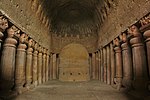Salsette Island
All accuracy disputesFormer Portuguese coloniesGeography of MumbaiGeography of Thane districtIslands of Mumbai ... and 2 more
Pages with non-numeric formatnum argumentsUse Indian English from July 2017

Salsette Island is an island in Konkan division of the state of Maharashtra on India's west coast. Administratively known as the Greater Mumbai, the city district of Mumbai, Mumbai Suburban District, Mira Bhayander and a portion of Thane lie within it, making it very populous and one of the most densely populated islands in the world. It has a population of more 20 million inhabitants living on an area of about 619 square kilometres (239 sq mi).
Excerpt from the Wikipedia article Salsette Island (License: CC BY-SA 3.0, Authors, Images).Salsette Island
Mumbai Thakur Village (Zone 4)
Geographical coordinates (GPS) Address Nearby Places Show on map
Geographical coordinates (GPS)
| Latitude | Longitude |
|---|---|
| N 19.2 ° | E 72.9 ° |
Address
Damu Nagar
400101 Mumbai, Thakur Village (Zone 4)
Maharashtra, India
Open on Google Maps





